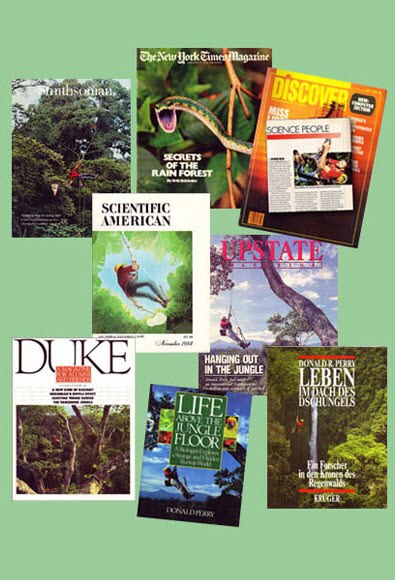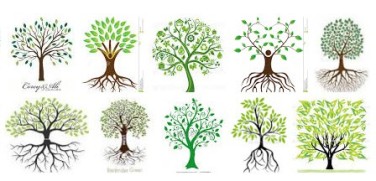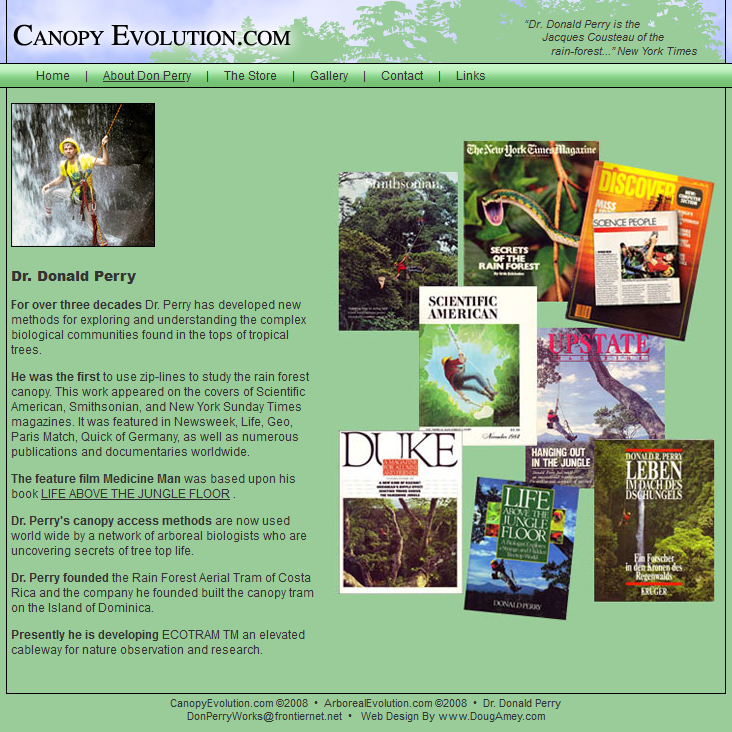File:Don Perry, Life Above the Jungle Floor.jpg

Original file (600 × 800 pixels, file size: 191 KB, MIME type: image/jpeg)
February 2, 2022
Remembering Adventures
Yes, Don is still at it, up in the canopy, now in Costa Rica.
And yes we had a good run when he was, as I used to say when introducing him to book and magazine publisher, the 'Jacques Cousteau of the Rainforest', the richest biosphere on earth. Our goal was to introduce people from around the world to what's worth protecting, up there, high above the jungle floor. "No machetes needed!"
Here is one of the first books. Simon & Schuster. Mid 1980s. Has a special place on my bookshelf.(SJS)
Life Above the Jungle Floor: A Biologist Explores a Strange and Hidden Treetop World
Simon and Schuster, First Published in 1986
5.0 out of 5 stars A MUST HAVE!!
Reviews @Amazon
THIS is a book I have cherished for over 25 years! I encountered it whilst beginning my journey towards obtaining a degree in Zoology, later specializing in Ornithology, the study of birds, and bird song, and how birds use altitude and plant / tree saturation to communicate in different ways and to change the sound of their calls and songs, as well as the distance they traveled through the air to their destination, to another bird. This Author clearly is an expert, is passionate in his field and takes us on a fascinating journey into, and within, the rainforests of the world. He begins on the floors of the forest, telling us what lives there and why. He speaks of the rainy season, where water rises so high in the jungle that it can cover 300 ft. trees! And, during this time, the beautiful, rare, endangered, and magical to tribal shaman, pink dolphins appear. They have traveled perhaps tens to hundreds of miles from salty waters but have adapted to tolerate the fresher waters of the jungle. They are pink due to their diet that consists partly of crustaceans and they take on their pink color. The Author then goes on describing levels of the jungles up the heights of the tree trunks, where the orchids grow only from one perfect seed, landing on one opportunistic spot, that just happens to be perfect for growth. Orchids are some of the rare plants that grow naturally on trees, in crooks of branches, in little piles of dirt and plant waste, and not on the ground. He brings you up higher and higher, until he is in the uppermost canopy, where most of the activity is of birds. As far as I know, the pictures in this book have not been obtained by any other scientists, for many years since this book was written, but may exist now. This book is a MUST for anyone! It takes us on a magical journey, to a place we may never have the chance to see! It makes us appreciate the wonders of our world. It gives us the hunger to protect these places, even if we never see them, but just to know.... to have the comfort, they still exist, for others, for our children, for distant generations... It is absolutely one of the most treasured things I own. I will share it with my children one day. Buy it, read it. Let it take you to a place of wonder. Let it light that spark for you to travel. Let it help you to remember to protect our world. Ranching has greatly reduced the size of these areas, as it has become a lucrative way of life in some areas. Become passionate enough to keep track of the situation, to help if you can. There are a couple of very reputable organizations that help protect areas like these by actually buying the land via donations. That is how I found out about the Nature Conservancy. In my opinion they have grown so much since their beginning and saved so many rare places like this. I have no association with them. This is just my personal opinion. But when you read this book, you will not be able to hold yourself back. You will feel compelled to do something to help. This book is that good! Teachers! Parents! Friends! Get this book! Teach our future generations! Show them the wonder, the strength, the mystery, the beauty our world has to offer! Take them on this journey with you! I promise you, you or they, will never forget this book. It's that good! Enjoy it! And thank you for reading my lengthy review! This book deserves it!
🌎
NYT / 1988
In coming years, Perry hopes, even bigger automated webs will open new realms for jungle researchers the way scuba gear did for explorers of the seas… It takes reminding that we are making a rare foray into territory that scientists consider equivalent to an unexplored continent. The discovery of life in the rain forests has hardly begun, but the findings already made about the multitudes of plants and animals and their extraordinary interrelations leave many biologists almost breathless.
"If I were 30 years younger, I'd be hanging up there in the ropes myself," says Edward O. Wilson, the 58-year-old Harvard biologist.
THANKS mainly to the warnings of conservationists, by now nearly everyone has heard superlatives about the dwindling rain forests of tropical Africa, Asia and Latin America. Why they abound with so many species is debated. Many, scientists, though not all, Wilson says, attribute it to a combination of factors: the equable climate that allows year-round growth, and the relatively long history that some areas in the tropics, known as refugia, have enjoyed without major climate change, allowing more time for species to evolve. Whatever the reasons, jungles comprise the richest ecosystems on earth, and the least examined. They are home to millions of unnamed plants and animals and have untold lessons to teach about the history and workings of life. This holds doubly true for the upper stories, from some 30 feet above ground to the 150-foot-plus crowns of forest behemoths. There, all-important sunlight drives a riotous dance of life.
"Biologically, that's the hot spot of the forest," said Alan P. Smith, an ecologist at the Smithsonian's Tropical Research Institute in Panama. "That's where most of the photosynthesis is, and most of the plant-animal interactions. That's where the growing tips of the plants are."
Perhaps two-thirds of the rain-forest species live aloft; many plants and animals are born, reproduce and live their entire lives without ever touching the ground. It is estimated that as many as half of all life forms may live in the jungle canopy (most, without doubt, insects).
We stop alongside trees laden with epiphytes, plants that grab nutrients and water from the air and transform many branches into exotic gardens.
Epiphytes - the word comes from Greek for upon plants - use trees for physical support but do not, like parasites, sap nutrients from their hosts. They include not only the ferns, mosses, lichens and liverworts seen in northern forests, but also arboreal cactuses and bromeliads. The latter, relatives of the pineapple, often store rainwater at the base of their erect leaves, supporting microcommunities of insects and even frogs.
And, more than anything else, the epiphytes include orchids. Most of the world's 20,000 species of orchids live on the trunks or branches of tropical trees. In Costa Rica alone, more than 1,100 species of orchids have been identified.
In the late afternoon, just after we glide past a primeval tree fern, Perry halts next to a colorful vine. On stiff stalks are tiny closed flowers and rows of red, ladle-shaped nectaries that attract a variety of hungry birds. A few years ago, watching at another site, Perry made a circumstantial case that this vine uses birds' feet to transport its pollen from one plant to another; the gummy pollen, he believes, sticks to the feet of nectar-sippers and is rubbed off later. If true, Perry says, this is a reproductive strategy scientists have rarely seen.
It is good luck that the same plant grows here, he says, so that observations can continue. Perry's critics in the scientific world charge that many of the observations he has made during more than a decade of research in Costa Rica have been reported as anecdotes in his 1986 book, Life Above the Jungle Floor, and in popular magazines rather than as carefully documented cases in journals. He has no intention, he adds, of carrying out the tedious studies necessary to convince skeptical scientists of his birds'-feet theory. "I'm not going to spend five years proving something I think is obvious," he says.
For about a dozen years now, Perry has been a promoter of canopy exploration... "I'm a naturalist," he says. Nor does he apologize for the publicity he wangles, asking: "Why shouldn't I pick a beautiful site that will make the jungle seem more accessible to laymen?" He figures he has done more than many academic specialists to stir public interest in rain-forest ecology and conservation.
January 2013
On Top of the World
Looking Out with Don Perry, the 'Jacques Cousteau of the Rainforest Canopy'
by Steve Schmidt - GreenPolicy360 Siterunner
I want to say a few words about Don Perry, Dr. Perry, who swung in and posted a couple comments yesterday, thirty plus years after we first started publishing Don's pioneering work 'up above'.
Be aware, Don is not your standard scientist who has dwelt in academia, collecting accolades and plaudits for his lifetime of work and explorations of the bio-universe. Don has gone on from UCLA to literally change the way we see our world.
As I used to say about Don, when we were working together back when I lived in LA and he was starting his career that would revolutionize the science of tropical forest study, Don is unique in his field, he's a pioneer (and "bioneer"), he's an explorer, an inventor. Don invented new techniques and methods for ascending and studying the 'real jungle', up above far from LA's glam, and proceeded to enable and show us what the resplendent, amazing rainforest, the richest biosphere on earth, the canopy, was like and it was wonderful... first-ever pictures and reports and science from on high. I was privileged to help as his representative and we saw Don's visions reach audiences around the world as he opened eyes to the eco-wonders of the environment we live in and the world we came from long ago, that is, if you believe in evolution... Don was a "Jacques Cousteau of the Rainforest Canopy." I meant the words when I said them and still do. Don's pioneering work has been featured in Scientific American, National Geographic, Smithsonian, New York Sunday Times magazine, Life, Newsweek, Paris Match, Quick of Germany, Popular Science, and many more popular and scientific media.
I have to say that Don's career is one-of-a-kind, an unparalleled feat of brave, courageous ascents and creative imagination and engineering that followed, from Topanga canyon w/ Southern Cal beginnings, to cross-bows firing lines and stringing canopy webs and going up himself, then a first-gen automated canopy exploration web system, to the first aerial, eco-trams for non-scientists and tourists and eco-preneurs, and zip line projects for all of us world over, Don has been reaching up for decades, surviving close calls and still going strong.
Don has changed the way we see "the jungle". I can't remember how many times I've explained over the years that the jungle isn't the way most everyone thinks about it -- it's not about Victorian-like stories, there's no machete at the ready, natives chopping away and a gun slung on a strap on your shoulder like Stanley and Livingston or Tarzan or Sheena, Queen of the Jungle, Hollywood's film versions of the jungle. Rather, the real jungle's up there, the richest biosphere, 60, 80, 100, 120 feet up and higher (think Amazon and meters if you want.) It's really up above, what I used to call "the cradle of new life forms", where evolution is still happening and happening fast... we're talking about life forms few have seen and studied, a gazillion types and insects and small creatures and green species, varieties, animals whose lives are lived out quickly and generation to generation in a geo-minute or -second, survival or not and adaptation happening in evolutionary timelines.
We now are seeing and witnessing and in the past few decades realizing the impacts and dangers to the rain forests, even before we discover the genetic environments we're wiping out as we clear cut and burn and rip away, humans interjecting profound change by destroying the rain forests worldwide. This story that science is now beginning to bring to us stands in contrast to green biodiversity and saving life, a pro-life position, where science and voices like Don's and those of us who've lived the life of being green are telling us - ACT, ACT NOW, for our own global health and well-being, act to save, be "conservative", truly conservative, not "crazy conservative", pay attention to the facts, conserve, conserve now, fast
Don was (and is) an original eco-explorer who realized the need to see what is at stake, he saw and he created an EcoTram, as it's now called, one of the first eco-explorer ventures designed to teach up close. He's devoted himself to the work, taking science to the next step, acting on his discoveries. The eco-trams jump started eco-tourism up above in the canopies, as they carry eco-tourists thru the tropical forests where they can come eye-to-eye with life's rich diversity. In Costa Rica as one of his trams, a first, has been running near San Juan, for years w/ travelers and adventurers from Europe, the US, Asia and around the world experiencing personally the real, diverse variety of life in the canopy and, as Don and our hopes began to come to be, all of these first-timers could become evangelists, returning home to tell their stories of what the real world is like up there and why it's worth saving. There's no better way to teach than up close, 'hands on', as Mr. Wizard, Don Herbert would tell me when I was editing his work. Up close in the canopy, eco-visiting people can sense, feel, touch, smell the richness and truly appreciate what it is, what we are trying to save when we talk about saving the tropical forests, the lungs of the earth and much more. It's about Gaia, it's about breathing and much more
Thank you Don
Thank you for going up there in the old days and ever since
The trees are where we came from... spires, in'spiration' we 'aspire' to a 'heaven' up above, cathedrals spire above, our language imagining goodness as we look up... and as we've evolved since our descent, let's rediscover what we left, rich, very rich and needed life
Thank you, you've battled and your new directions, your work on more e-trams, your questioning of human evolution beginning w/ us as the "greatest climbers", your thoughts here on the future of sea rise as you wrote about yesterday on my my FB wall as I mulled about Doonesbury's myFacts take on global warming deniers, (especially pertinent to us folks who live barely above sea level), I want you to know you're truly appreciated
File history
Click on a date/time to view the file as it appeared at that time.
| Date/Time | Thumbnail | Dimensions | User | Comment | |
|---|---|---|---|---|---|
| current | 15:59, 2 February 2022 |  | 600 × 800 (191 KB) | Siterunner (talk | contribs) |
You cannot overwrite this file.


